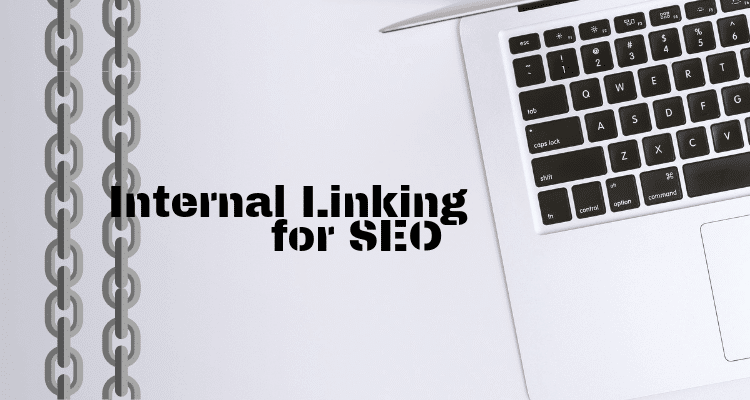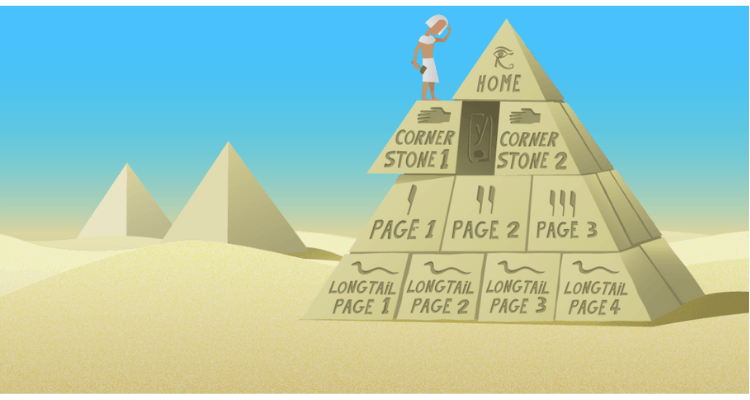The tables may have turned lately, and all the attention has shifted towards optimizing for users, but we can’t easily shrug off the importance of SEO still. Both onsite and offsite SEO is needed so you can rank for that coveted spot on SERPs. But you can’t properly do your offsite SEO without paying attention to your own internal link structure first.

Why does your site need a proper internal linking structure?
Everything involving digital marketing practices needs a structure — one way or the other. So, yes that means internal linking has its own ideal structure to follow.
And you need internal links because that’s how you can rank properly. The search engine, Google — in particular, finds your pages and posts better when they’re linked from other pages on the web. Basically, Google makes use of links to find out which content is related to which on your site.
The Value of a Link

Notice how most websites’ homepage has the greatest link value? That’s because the homepage often has the most backlinks.
In the words of Meike Hendriks, from Yoast, “Google divides link value between all links on a web page.”
Let’s go back to the one page on the site that has the most value — the homepage. That link value is shared between all of the links found on the homepage. That link value will pass on to the following page, and again, the value of the previous link will be divided between all the links found on that page, and the cycle goes on.
The bottom line?
Links pass their link value to the next and the next and the next. More links to a post consequently mean more value.
We know that Google deems a page that gets lots of valuable links as important. And in doing your internal linking right, you can increase the chances of your page ranking.
The Relationship Between Links and Content
Following the value of a link, it’s worth noting that Google crawls websites when it follows links — both external and internal. Google’s bots arrive at a website homepage, analyze, and follow the first link.
As the search engine, bots continue to follow links, Google can easily work out the existing relationship between the posts, the pages, and other pieces of content. It’s in this method that Google understands the relationships between your site content. Google can find which pages on the website cover a similar subject matter.
The Ideal Internal Linking Structure
In updating an existing site, launching a new website, or completely restructuring content, the proper internal linking structure is crucial to your SEO success. If you haven’t done a proper internal linking structure, you’re missing out on a bountiful opportunity to improve your SEO efforts while creating an enriching user experience for all your site visitors.
It’s like building a pyramid

[Image Credit: Yoast]
I will follow up on Yoast’s fabulous advice to all website owners.
It’s ideal to imagine your website as a pyramid; the very important content goes at the top, and the supporting ones are at the foundation. The very important content is accurately labeled as cornerstone content.
Remember what we said about link value being passed down from page to page?
It’s advisable that a lot of relevant links should be found in the cornerstone content. Marketers advise that you should link internally to related content to show Google which pages hold information about slightly identical topics.
Add links to the cornerstone content
Let’s say, for instance, your cornerstone article is entitled: “How to Do Proper CRO Auditing.”
You want this piece of content to rank on all search queries that are related to CRO auditing. You can then proceed to add internal links from articles like, “5 Steps to Doing a Landing Page CRO Audit,” or “20 Mistakes to Avoid in Doing Your CRO Auditing.”
This way, it would be easy for Google to understand that your cornerstone article contains the most information about CRO auditing. Consequently, Google will rank that piece of content higher than the shorter articles about CRO auditing.
And aside from linking to pages and posts with similar topics, you can make your cornerstone article more authoritative when you add links to it from the homepage. These filters link value to a lot of posts and pages and makes them more valuable in Google’s eyes.
Link to the category
So Google can understand the structure of the blog, and so visitors can easily navigate through all of your related posts, it’s advisable to always link to the matching categories and tags.
Linking to the newest post and the most popular ones
Linking to your most recent articles and most popular ones gives your other posts the chance to be seen by your new blog visitors. This way, you can direct traffic more smoothly towards your other posts, adding link value while telling Google to crawl a specific article.
Establishing links between related posts
We have established that linking to related posts helps Google understand the website’s structure. And linking one or more related articles at the end of the post is just sweetening the deal. Also, be wary and use the right anchor texts to add your links too. Ensure that your anchor text looks natural in your article.
Things to Remember in a Proper Internal Linking Structure
This lesson on internal linking doesn’t stop at figuring out how to create a proper internal linking structure for SEO purposes. There are also best practices you have to take into account and live by if you want your internal linking to succeed.
Producing original content
It’s pretty much a given at this point. In order to build a strong brand and establish a point of authority, you are required to produce unique content — preferably never seen before. Or if not, then a popular topic viewed from a unique perspective.
Keep in mind that Google filters duplicate content in the results. Having the same results as everybody else isn’t going to help your case at all. In fact, it’s more difficult to break through common content, because rest assured, every big fish in the water is lurking. You’ll go unnoticed — unless you hit the right spot with people and Google.
Prioritizing user experience
Over the years, user experience has become a priority. Don’t torture your site visitors with poor content and far too many interrupting ads that would ruin the user experience. Nothing makes a visitor bounce faster than an intrusive advert popping up every three seconds.
It doesn’t really matter how awesome your sales proposition is. If they can’t find it on their own, then doesn’t that defeat the purpose of your link-building?
Search engines care about their searchers, and when you cater to that need, they can be generous enough to reward your efforts for positive user experiences.
Inviting the site crawlers and getting indexed
Awesome content and a proper internal linking structure are useless if the bots can’t crawl it. So avoid unnecessary navigation on each of your site’s pages.
You see, the focus here is to get search engines to see all of your content and trace a path to sift through the depth of content in various topical areas. In addition, we need to make sure that Google understands the association we form between our site pages.
The Takeaway

It’s true that most of the attention has shifted to content lately, but let’s not forget that links are still a ranking factor in today’s ranking system.
So, yes, you do need a proper internal linking structure to get that link value flowing and to help Google see how your pages relate to one another.
In creating the proper internal linking structure remember to:
- Look at your website like it’s a pyramid
- Add links to the cornerstone content
- Link to categories, most recent posts, and most popular posts
- Establish links between related posts
Author Bio::
Al Gomez is a digital marketing consultant. He is the President and Founder of SEO Perth. He also specializes in SEO, PPC, & web development since 2008. Al has over 10 years of client digital marketing experience and has helped businesses use the web to drive online visibility and generate leads. He has even started, developed, and managed an e-commerce website — Unlideals.com, and an SEO site, dlinkers.com
Read Also:

thanks for giving me the knowledge.
Thank you very much Techsinfo for sharing this valuable information and i will apply these tips to my sites.
Thank you.
Dear Techsinfo, thanks for sharing tips on internal linking.
You are welcome!